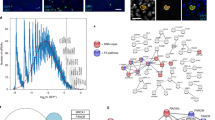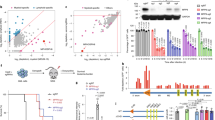Abstract
Long interspersed nuclear elements-1 (L1s) are highly repetitive DNA elements that are capable of altering the human genome through retrotransposition. To protect against L1 retroposition, the cell downregulates the expression of L1 proteins by various mechanisms, including high-density cytosine methylation of L1 promoters and DICER-dependent destruction of L1 mRNAs. In this report, a large number of p53 responsive elements, or p53 DNA binding sites, were detected in L1 elements within the human genome. At least some of these p53 responsive elements are functional and can act to increase the levels of L1 mRNA expression. The p53 protein can directly bind to a short 15-nucleotide sequence within the L1 promoter. This p53 responsive element within L1 is a recent addition to evolution, appearing ∼20 million years ago. This suggests an interplay between L1 elements, which have a rich history of causing changes in the genome, and the p53 protein, the function of which is to protect against genomic changes. To understand these observations, a model is proposed in which the increased expression of L1 mRNAs by p53 actually increases, rather than decreases, the genomic stability through amplification of p53-dependent processes for genomic protection.
This is a preview of subscription content, access via your institution
Access options
Subscribe to this journal
Receive 50 print issues and online access
$259.00 per year
only $5.18 per issue
Buy this article
- Purchase on Springer Link
- Instant access to full article PDF
Prices may be subject to local taxes which are calculated during checkout






Similar content being viewed by others
References
Babushok DV, Kazazian Jr HH . (2007). Progress in understanding the biology of the human mutagen LINE-1. Hum Mutat 28: 527–539.
Bensaad K, Vousden KH . (2005). Savior and slayer: the two faces of p53. Nat Med 11: 1278–1279.
Brouha B, Schustak J, Badge RM, Lutz-Prigge S, Farley AH, Moran JV et al. (2003). Hot L1s account for the bulk of retrotransposition in the human population. Proc Natl Acad Sci USA 100: 5280–5285.
Budhram-Mahadeo V, Morris PJ, Smith MD, Midgley CA, Boxer LM, Latchman DS . (1999). p53 suppresses the activation of the Bcl-2 promoter by the Brn-3a POU family transcription factor. J Biol Chem 274: 15237–15244.
Bunz F, Dutriaux A, Lengauer C, Waldman T, Zhou S, Brown JP et al. (1998). Requirement for p53 and p21 to sustain G2 arrest after DNA damage. Science 282: 1497–1501.
Cho Y, Gorina S, Jeffrey PD, Pavletich NP . (1994). Crystal structure of a p53 tumor suppressor-DNA complex: understanding tumorigenic mutations. Science 265: 346–355.
Donehower LA . (2005). p53: guardian AND suppressor of longevity? Exp Gerontol 40: 7–9.
el-Deiry WS, Kern SE, Pietenpol JA, Kinzler KW, Vogelstein B . (1992). Definition of a consensus binding site for p53. Nat Genet 1: 45–49.
Esteve PO, Chin HG, Pradhan S . (2005). Human maintenance DNA (cytosine-5)-methyltransferase and p53 modulate expression of p53-repressed promoters. Proc Natl Acad Sci USA 102: 1000–1005.
Funk WD, Pak DT, Karas RH, Wright WE, Shay JW . (1992). A transcriptionally active DNA-binding site for human p53 protein complexes. Mol Cell Biol 12: 2866–2871.
Han JS, Szak ST, Boeke JD . (2004). Transcriptional disruption by the L1 retrotransposon and implications for mammalian transcriptomes. Nature 429: 268–274.
Haoudi A, Semmes OJ, Mason JM, Cannon RE . (2004). Retrotransposition-competent human LINE-1 induces apoptosis in cancer cells with intact p53. J Biomed Biotechnol 2004: 185–194.
Harris SL, Levine AJ . (2005). The p53 pathway: positive and negative feedback loops. Oncogene 24: 2899–2908.
Hoh J, Jin S, Parrado T, Edington J, Levine AJ, Ott J . (2002). The p53MH algorithm and its application in detecting p53-responsive genes. Proc Natl Acad Sci USA 99: 8467–8472.
Hollander MC, Alamo I, Jackman J, Wang MG, McBride OW, Fornace Jr AJ . (1993). Analysis of the mammalian gadd45 gene and its response to DNA damage. J Biol Chem 268: 24385–24393.
Hollstein M, Sidransky D, Vogelstein B, Harris CC . (1991). p53 mutations in human cancers. Science 253: 49–53.
Hu W, Feng Z, Teresky AK, Levine AJ . (2007). p53 regulates maternal reproduction through LIF. Nature 450: 721–724.
Jin S, Levine AJ . (2001). The p53 functional circuit. J Cell Sci 114: 4139–4140.
Jordan JJ, Menendez D, Inga A, Nourredine M, Bell D, Resnick MA . (2008). Noncanonical DNA motifs as transactivation targets by wild type and mutant p53. PLoS Genet 4: e1000104.
Jurka J . (2000). Repbase update: a database and an electronic journal of repetitive elements. Trends Genet 16: 418–420.
Kannan K, Kaminski N, Rechavi G, Jakob-Hirsch J, Amariglio N, Givol D . (2001). DNA microarray analysis of genes involved in p53 mediated apoptosis: activation of Apaf-1. Oncogene 20: 3449–3455.
Kern SE, Kinzler KW, Bruskin A, Jarosz D, Friedman P, Prives C et al. (1991). Identification of p53 as a sequence-specific DNA-binding protein. Science 252: 1708–1711.
Khan H, Smit A, Boissinot S . (2006). Molecular evolution and tempo of amplification of human LINE-1 retrotransposons since the origin of primates. Genome Res 16: 78–87.
Kwon HS, Huang B, Ho Jeoung N, Wu P, Steussy CN, Harris RA . (2006). Retinoic acids and trichostatin A (TSA), a histone deacetylase inhibitor, induce human pyruvate dehydrogenase kinase 4 (PDK4) gene expression. Biochim Biophys Acta 1759: 141–151.
Lander ES, Linton LM, Birren B, Nusbaum C, Zody MC, Baldwin J et al. (2001). Initial sequencing and analysis of the human genome. Nature 409: 860–921.
Lane DP . (1992). Cancer. p53, guardian of the genome. Nature 358: 15–16.
Lavin MF, Gueven N . (2006). The complexity of p53 stabilization and activation. Cell Death Differ 13: 941–950.
Lee KC, Crowe AJ, Barton MC . (1999). p53-mediated repression of alpha-fetoprotein gene expression by specific DNA binding. Mol Cell Biol 19: 1279–1288.
Lorincz MC, Dickerson DR, Schmitt M, Groudine M . (2004). Intragenic DNA methylation alters chromatin structure and elongation efficiency in mammalian cells. Nat Struct Mol Biol 11: 1068–1075.
Maltzman W, Czyzyk L . (1984). UV irradiation stimulates levels of p53 cellular tumor antigen in nontransformed mouse cells. Mol Cell Biol 4: 1689–1694.
Ori A, Zauberman A, Doitsh G, Paran N, Oren M, Shaul Y . (1998). p53 binds and represses the HBV enhancer: an adjacent enhancer element can reverse the transcription effect of p53. EMBO J 17: 544–553.
Ostertag EM, DeBerardinis RJ, Goodier JL, Zhang Y, Yang N, Gerton GL et al. (2002). A mouse model of human L1 retrotransposition. Nat Genet 32: 655–660.
Ostertag EM, Prak ET, DeBerardinis RJ, Moran JV, Kazazian Jr HH . (2000). Determination of L1 retrotransposition kinetics in cultured cells. Nucleic Acids Res 28: 1418–1423.
Pochampally R, Fodera B, Chen L, Lu W, Chen J . (1999). Activation of an MDM2-specific caspase by p53 in the absence of apoptosis. J Biol Chem 274: 15271–15277.
Resnick-Silverman L, St Clair S, Maurer M, Zhao K, Manfredi JJ . (1998). Identification of a novel class of genomic DNA-binding sites suggests a mechanism for selectivity in target gene activation by the tumor suppressor protein p53. Genes Dev 12: 2102–2107.
Tchenio T, Casella JF, Heidmann T . (2000). Members of the SRY family regulate the human LINE retrotransposons. Nucleic Acids Res 28: 411–415.
Wang T, Zeng J, Lowe CB, Sellers RG, Salama SR, Yang M et al. (2007). Species-specific endogenous retroviruses shape the transcriptional network of the human tumor suppressor protein p53. Proc Natl Acad Sci USA 104: 18613–18618.
Woodcock DM, Lawler CB, Linsenmeyer ME, Doherty JP, Warren WD . (1997). Asymmetric methylation in the hypermethylated CpG promoter region of the human L1 retrotransposon. J Biol Chem 272: 7810–7816.
Zhao R, Gish K, Murphy M, Yin Y, Notterman D, Hoffman WH et al. (2000). Analysis of p53-regulated gene expression patterns using oligonucleotide arrays. Genes Dev 14: 981–993.
Acknowledgements
This work was primarily supported by the Verto Institute, with additional support provided by NIH Grant nos K25HG00060, R01EY015771, R01MH44292 and P01CA87497.
Author information
Authors and Affiliations
Corresponding author
Additional information
Supplementary Information accompanies the paper on the Oncogene website (http://www.nature.com/onc)
Supplementary information
Rights and permissions
About this article
Cite this article
Harris, C., DeWan, A., Zupnick, A. et al. p53 responsive elements in human retrotransposons. Oncogene 28, 3857–3865 (2009). https://doi.org/10.1038/onc.2009.246
Received:
Revised:
Accepted:
Published:
Issue Date:
DOI: https://doi.org/10.1038/onc.2009.246
Keywords
This article is cited by
-
Translating p53-based therapies for cancer into the clinic
Nature Reviews Cancer (2024)
-
TP53 drives abscopal effect by secretion of senescence-associated molecular signals in non-small cell lung cancer
Journal of Experimental & Clinical Cancer Research (2021)
-
Prognostic implications and interaction of L1 methylation and p53 expression statuses in advanced gastric cancer
Clinical Epigenetics (2019)
-
Contrasted patterns of evolution of the LINE-1 retrotransposon in perissodactyls: the history of a LINE-1 extinction
Mobile DNA (2018)
-
Restricting retrotransposons: a review
Mobile DNA (2016)



